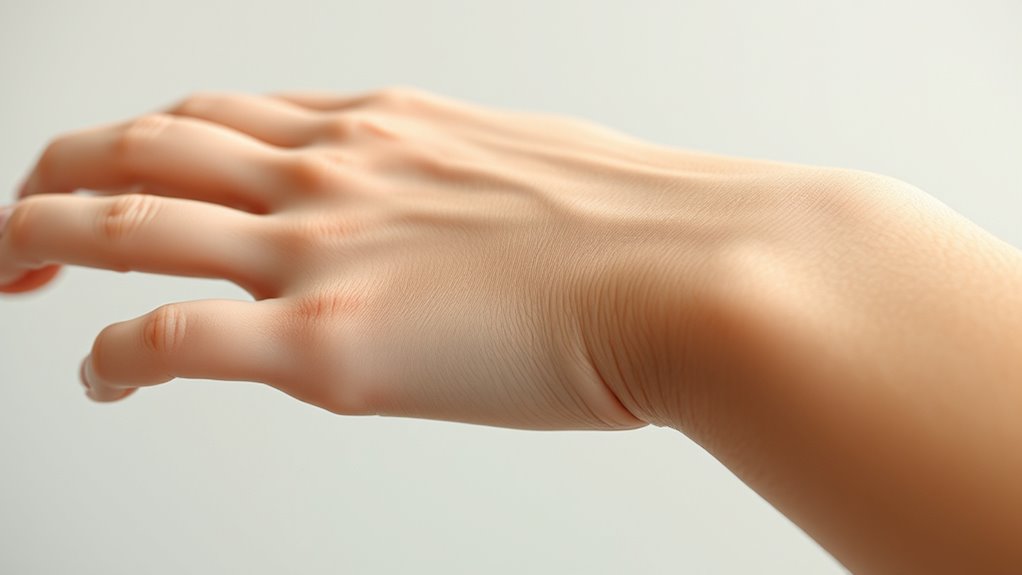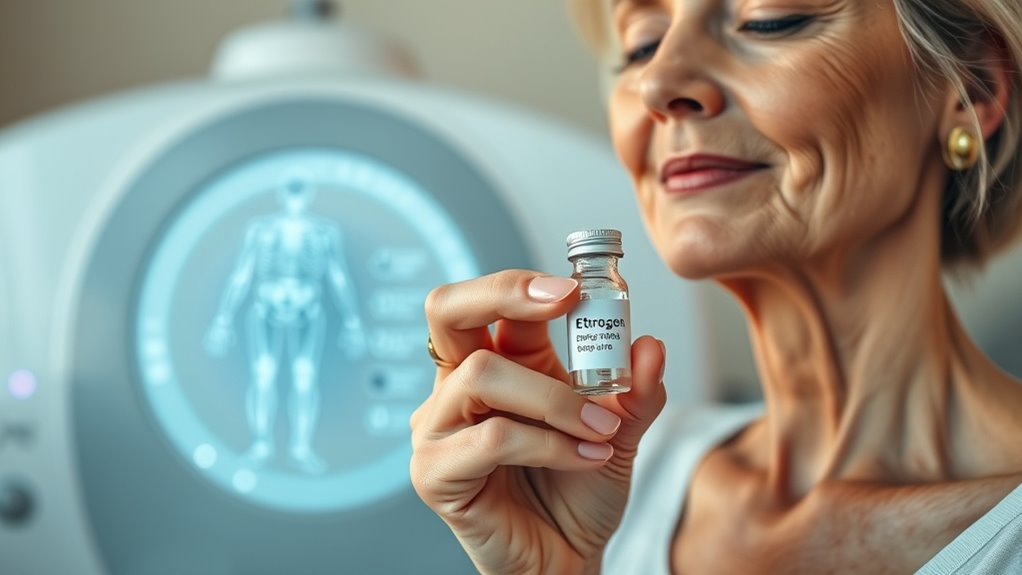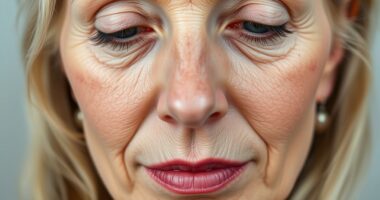Estrogen plays a pivotal role in maintaining your bone health by balancing bone resorption and formation, especially during menopause when its levels drop sharply. This decline leads to faster bone loss, weakening your bones and increasing fracture risk. Hormone therapy and lifestyle choices like calcium intake and weight-bearing exercise can help mitigate these effects. To understand how to better protect your bones during this shift, you’ll find helpful insights if you continue exploring this topic.
Key Takeaways
- Estrogen regulates bone remodeling by inhibiting osteoclast activity and promoting osteoblast function, maintaining bone density.
- During menopause, estrogen levels decline sharply, leading to increased bone resorption and accelerated bone loss.
- Estrogen deficiency causes microfractures, deterioration of bone architecture, and heightened fracture risk.
- Hormone therapy helps preserve bone mineral density and microarchitecture by maintaining estrogen levels.
- Adequate calcium, vitamin D, and weight-bearing exercise support bone health during menopause.
The Protective Role of Estrogen in Bone Maintenance

Estrogen plays a essential role in maintaining bone health by regulating the process of bone remodeling. It keeps your bones strong by balancing bone resorption and formation. Estrogen inhibits osteoclast activity, which reduces bone breakdown, allowing osteoblasts to build new bone tissue more effectively. When your estrogen levels are adequate, your bones stay dense and resilient, minimizing bone loss and preserving their structure. This hormone promotes osteoblast activity, fundamental for creating new bone. Without enough estrogen, bone resorption increases, especially in spongy and cortical bones, leading to faster loss. This imbalance weakens your bones over time, making them more vulnerable to fractures. Maintaining healthy estrogen levels is essential for long-term bone strength and reducing the risk of osteoporosis. Additionally, hormonal balance plays a crucial role in overall bone health and prevention of degenerative conditions.
Changes in Estrogen Levels During Menopause

During menopause, your body’s estrogen levels undergo significant changes that directly impact various physiological functions. Typically, estrogen fluctuates unpredictably during perimenopause, starting between ages 40 and 44, sometimes earlier. About six months before menopause, estrogen drops sharply, leading to symptoms like hot flashes and irregular periods. As estrogen declines, your ovaries produce less, and FSH levels rise in response. Menopause is diagnosed after 12 months without menstruation, confirming persistent low estrogen. The table below shows how estrogen levels change:
| Stage | Estrogen Levels | Key Effects |
|---|---|---|
| Perimenopause | Fluctuate unpredictably | Irregular cycles, symptoms |
| Approaching menopause | Sharp decline (~6 months before) | Hot flashes, night sweats |
| Postmenopause | Remain low (1/10th of premenopause) | System-wide effects |
These changes mark a permanent shift in hormonal balance, influencing your overall health. Understanding the hormonal fluctuations involved can help you better manage associated symptoms. Additionally, the decline in estrogen can affect bone density, increasing the risk of osteoporosis in postmenopausal women. A decrease in estrogen also impacts other tissues and systems, contributing to a variety of health concerns.
How Estrogen Decline Affects Bone Density and Fracture Risk

As estrogen levels decline in menopause, the balance between bone resorption and formation shifts, leading to increased bone loss. Estrogen normally inhibits osteoclast activity, which slows down bone breakdown. When estrogen drops, osteoclast activity rises, causing more bone to be resorbed faster than it’s rebuilt by osteoblasts. This accelerates the natural decline in bone density that starts around age 30 but worsens during menopause. You can lose up to 20% of your bone mass within the first decade after menopause, markedly raising your fracture risk. The weakened bones become more susceptible to fractures in the hip, spine, and wrist. These fractures can cause chronic pain, mobility issues, and reduce your overall quality of life. Preventing or slowing this process is vital for maintaining long-term bone health. Fokos provides valuable insights into managing and understanding osteoporosis risk factors. Additionally, bone turnover increases as estrogen declines, further contributing to bone fragility.
The Connection Between Estrogen and Osteoporosis Development

When estrogen levels drop, your bones lose their balance between formation and breakdown, increasing osteoporosis risk. This decline, especially during menopause, causes bones to become porous and fragile. Understanding how estrogen protects bone health helps explain why women are more vulnerable to osteoporosis after menopause.
Estrogen’s Protective Role
Estrogen plays a pivotal role in protecting bone health by regulating the balance between bone formation and resorption. It promotes osteoblast activity, helping your bones stay strong, and suppresses osteoclasts that break down bone. When estrogen levels drop, especially after menopause, this balance shifts, leading to increased bone loss and higher osteoporosis risk. Clinical studies show estrogen’s effectiveness in reducing fractures, especially when started early. Additionally, understanding osteoporosis development can help in managing bone health effectively. Nutrient intake also influences bone health by providing essential minerals like calcium and magnesium that support bone density. Proper filter maintenance ensures continued air quality, which is vital for overall health, including bone health. Maintaining hormonal balance is crucial for sustaining bone density and preventing osteoporosis. Early intervention with appropriate therapies can significantly reduce the risk of severe bone deterioration and fractures.
Menopause-Induced Bone Loss
The decline in estrogen levels after menopause markedly accelerates bone loss, disrupting the balance between bone formation and resorption. During this period, you can lose about 50% of trabecular bone and 30% of cortical bone, especially within the first 10 years. Bone loss rates increase to around 1.8–2.3% annually in the spine and 1.0–1.4% in the hip. This rapid loss raises your fracture risk, with nearly 40% of postmenopausal women experiencing fractures. Trabecular bone, more susceptible to osteoporosis, diminishes faster than cortical bone. By age 80, women typically lose about 30% of their bone density due to menopause and aging. This imbalance in bone remodeling weakens bones, making fractures more likely and increasing osteoporosis prevalence among women over 50.
Benefits of Hormone Therapy for Postmenopausal Bone Health

Hormone therapy offers notable benefits for postmenopausal bone health by markedly reducing fracture risk and increasing bone mineral density. It prevents bone loss and preserves microarchitecture, key factors in avoiding fractures. Multiple studies show a consistent decline in fracture incidence during hormone therapy use, even with short-term treatment around menopause. You’ll see improvements in bone mineral density, especially in the lumbar spine, which can persist after stopping therapy. Early initiation during menopause provides better outcomes, and some benefits may last beyond treatment. Additionally, global culinary delights can serve as a flavorful reminder of diverse cultural traditions related to health and wellness. Incorporating nutrient-rich foods such as calcium and vitamin D can further support bone strength and osteoporosis prevention, which can complement hormone therapy’s effects.
Estrogen’s Influence on Bone Metabolism Processes

Understanding how estrogen influences bone metabolism reveals its essential role in bone growth, maturation, and maintenance. It regulates bone turnover by balancing formation and resorption, which keeps bones healthy. Estrogen’s presence guarantees proper closure of growth plates and prevents excessive bone loss. It inhibits osteoclast differentiation and activity, reducing bone resorption, mainly through cytokines like IL-1 and IL-6, and acts via ERα and ERβ receptors. When estrogen levels drop, osteoclast activity increases, leading to more bone breakdown. This accelerates resorption, especially in cancellous and cortical bone, weakening the skeleton. Estrogen also suppresses bone remodeling, helping maintain bone density. Its deficiency causes microfractures, architectural deterioration, and higher fracture risk, ultimately contributing to osteoporosis and compromised bone strength during menopause. Additionally, research-driven insights into bone metabolism enhance our understanding of how hormonal regulation impacts skeletal health. Furthermore, the integration of AI in medical research is paving the way for novel treatments and diagnostics in osteoporosis care. A deeper understanding of hormonal regulation can aid in developing targeted therapies to better support bone health in menopausal women.
Strategies to Prevent Bone Loss in Menopausal Women

To prevent bone loss during menopause, women can adopt a combination of medical, dietary, and lifestyle strategies that support bone health. Hormone therapy (HT) can be effective by maintaining estrogen levels, reducing bone resorption, and preventing fractures. However, it’s typically used short-term due to potential risks like blood clots and cancers. Dietary interventions include increasing calcium (1,200 mg daily) and vitamin D intake through foods such as dairy, leafy greens, and fortified products, or supplements if needed. Regular exercise, especially weight-bearing activities like walking or dancing, helps maintain bone density and improves strength and balance. Lifestyle adjustments like quitting smoking, moderating alcohol, managing stress, and maintaining a healthy weight further support bone health and reduce fracture risk. Additionally, understanding the role of affiliates in health product recommendations can help women make informed choices about supplements and treatments. Incorporating data analysis can also help tailor personalized strategies for optimal bone preservation. Moreover, focusing on nutrient-rich foods that support bone strength can enhance overall health outcomes. Exploring emerging research on novel osteoporosis therapies may provide additional options for women at high risk of fractures.
Frequently Asked Questions
Can Diet Alone Prevent Menopausal Bone Loss?
You wonder if diet alone can prevent menopausal bone loss. While eating a balanced diet rich in calcium, vitamin D, and healthy fats supports bone health, it can’t fully prevent loss caused by hormonal changes. You need more than just good nutrition—regular exercise, lifestyle choices, and sometimes medical treatments are essential. Combining these strategies gives you the best chance to maintain strong, healthy bones during menopause.
Are There Natural Alternatives to Hormone Therapy for Bone Health?
Think of your bones as a fortress, needing strong defenses to withstand time’s assault. You don’t have to rely solely on hormone therapy; natural alternatives can act like loyal sentinels. Botanical options like red clover extract, phytoestrogens, and mineral-rich herbs bolster your bone fortress. Nutritional supplements—calcium, vitamin D, collagen—serve as reinforcements. Combine these with healthy lifestyle choices like exercise and sun exposure to keep your bones resilient and fortified naturally.
How Quickly Does Bone Density Decline After Menopause?
After menopause, your bone density declines quite rapidly, especially in the first five years. You might lose about 7-10% in your spine and 5-7% in your hip during that time. The rate then slows but continues at around 0.5% to 1% annually. Factors like low body weight, smoking, and certain health conditions can make this decline happen even faster, increasing your fracture risk over time.
Is Hormone Therapy Safe for Long-Term Use?
Did you know that hormone therapy can be safe for many women when used appropriately? You might wonder if it’s safe for long-term use. While it offers benefits like reducing osteoporosis risk, the risks—such as blood clots, breast cancer, and heart disease—depend on your age, health, and how long you use it. Regular monitoring and personalized treatment plans are essential to guarantee its safety over time.
What Are Early Signs of Osteoporosis in Menopausal Women?
You might notice early signs of osteoporosis like receding gums, which suggest jaw bone loss, or a weak grip that indicates lower bone density. Brittle fingernails and loss of height can also be warning signs, as they reflect weakening bones, especially in the spine. Changes in posture, such as bending forward, are common late signs. Stay alert for these subtle clues to catch issues early and protect your bone health.
Conclusion
Understanding estrogen’s vital role in your bone health is crucial, especially during menopause. As your estrogen levels decline, your risk of osteoporosis and fractures rises—think of it as your bones losing their armor in a medieval siege. But don’t despair! Hormone therapy and lifestyle choices can help you stave off this fate. Stay proactive, embrace healthy habits, and remember, even Joan of Arc relied on her armor—your bones deserve the same protection.









